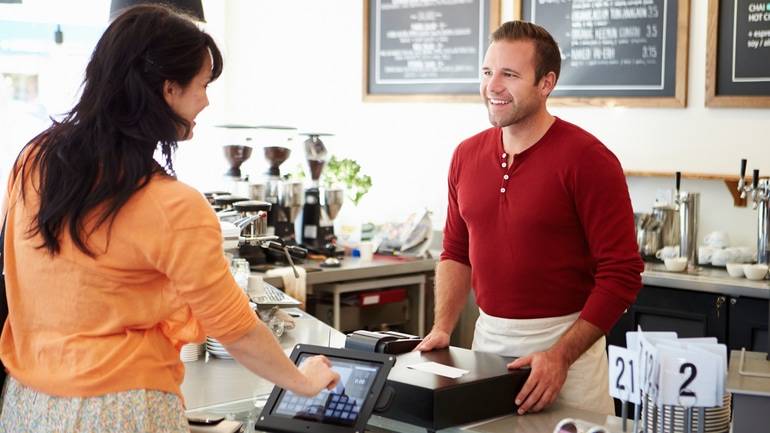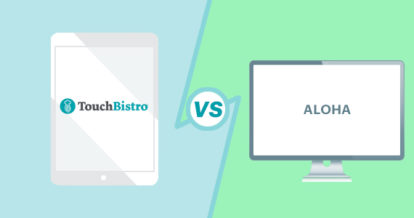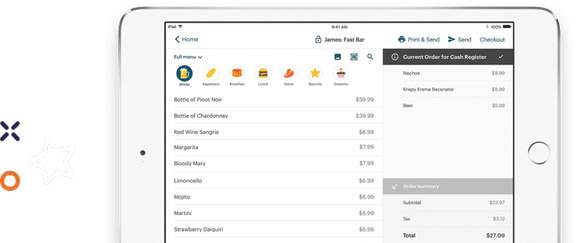| Don’t have time to read the full TouchBistro vs Aloha review? Here are the highlights |
| TouchBistro: – An all-in-one POS and restaurant management system designed exclusively for restaurants – Runs on iOS and Apple iPad tablets – Extensive in-house solutions, including integrated reservations and online ordering – 24/7 support available 365 days a year – Best for single and multi-location restaurants that are growing and scaling NCR Aloha: – Robust, highly technical features with customizable enterprise solutions – Legacy POS solution with slow-moving product development – Proprietary hardware and pricey monthly software fees – Limited customer service and technical support hours – Best for international restaurant chains and franchises with very specialized needs |
Shopping for a new restaurant POS system means comparing some of the biggest names out there, including TouchBistro vs Aloha.
Both TouchBistro and Aloha are popular POS systems used by restaurants around the world. But while these two providers may offer similar products, there are some major differences between the systems. From hardware to customer support, the variations between TouchBistro and the Aloha POS make each system best for very different types of restaurants.
Of course, spotting these differences isn’t always easy – unless you commit to hours of online research reading TouchBistro and Aloha POS user reviews.
So to make the whole process a little bit easier (and save you some valuable time), we’ve conducted a head-to-head comparison of TouchBistro vs Aloha restaurant software on all the features that matter to today’s restaurateurs.
In this thorough restaurant POS system comparison, we’ll cover:
- The foundations of each system
- Core POS features
- Hardware
- Payments
- Other add-on solutions
- Pricing
- Integration partners
- Customer support
Thanks to this in-depth guide, you’ll have all the information you need to answer the question of whether Aloha or Aloha competitor TouchBistro is the right POS system for your restaurant.
To learn more about other top POS systems, you can also check out our Ultimate Guide to the Best Restaurant POS Systems.
The information contained on this site is accurate as of the time of publication.

Compare the top legacy POS systems for restaurants on features, hardware, integrations, pricing, and more.
TouchBistro vs Aloha: An Overview
As leading solutions in payment processing and restaurant management, Aloha and TouchBistro are both systems highly rated and designed specifically to meet the needs of a wide variety of foodservice establishments.
But just because TouchBistro and Aloha are both leading restaurant POS systems, doesn’t mean that they’re one and the same. There are some major differences between the two systems that are important to understand upfront.
Below, we’ll provide a detailed overview of TouchBistro vs Aloha, including how the two systems differ and why it matters for restaurateurs who are in the market for a new POS.
| TouchBistro | NCR Aloha | |
| POS System | Hybrid cloud-based | Locally-installed with a cloud-based app |
| Operating System | iOS | Desktop System: Windows and Android Mobile Devices: iOS and Android |
| Regional Availability | CAD, U.S., and more | U.S., CAD, and more |
| Hardware (Tablets) | iPads | NCR Orderman and NCR 7779 Tablet (app can also be run on an iPad or iPhone) |
1. POS System
Perhaps the biggest difference between TouchBistro and Aloha is the setup of the POS system itself.
Aloha’s Legacy POS System
The Aloha POS has been around for quite some time and originally established a reputation as one of the top legacy POS systems. A legacy POS system is sometimes referred to as an “on-premise” or a “traditional” POS because all of the hardware and software is located on-site in the restaurant. This means that all your data is stored on local servers and runs on a closed internal network.
In 2011, Aloha’s parent company Radiant Systems was acquired by NCR Corporation, (previously known as National Cash Register). NCR then undertook the process of modernizing the Aloha POS to compete with newer cloud-based POS solutions. NCR’s efforts helped to turn the Aloha POS into a hybrid system that supplements the legacy system’s locally installed connection with a cloud-based app. The addition of the app means that Aloha restaurant software users can now access all of their POS data remotely with a mobile device such as a smartphone or tablet.
Although NCR has clearly taken steps to modernize its POS technology, there are still many drawbacks to Aloha’s current hybrid setup. The Aloha POS still mostly relies on proprietary hardware installed on-site in your restaurants. This means that if this hardware is damaged or needs to be updated, you may have to bring in a technician. In some cases, you may also need to purchase new hardware just to keep your POS system up to date. And if you’re a multi-unit restaurant using Aloha across your venues, that could mean spending tens of thousands just to replace outdated hardware.
TouchBistro’s Modern POS System
TouchBistro, on the other hand, is a modern POS system that runs on iPad tablets. Each of TouchBistro’s iPads is equipped with POS software that stores your data in the cloud via remote servers. This means that you can access your POS data from any device, at any time, as long as you have an Internet connection.
Since your hardware (the iPads) is not installed directly on-site, you benefit by not needing to bring a technician to your restaurant just to carry out updates or repairs. In fact, with a cloud-based system, updates are rolled out automatically across your devices, so you never have to worry about your operating system being out of date.
Of course, every restaurateur knows that relying on a strong internet connection can be risky. So to ensure that slow or unreliable internet doesn’t bring service to a standstill, TouchBistro also has an offline mode that can act as a backup if the Internet goes down in your venue. As a POS system that’s cloud-based with a built-in offline mode, TouchBistro ensures that there’s no risk of downtime, even if you lose your internet connection.

2. Operating System
In addition to the actual setup of the POS system, it’s important to understand the operating system that your POS software runs on.
Unlike most modern POS systems, Aloha customers have the option to choose between a Windows or an Android operating system for the countertop POS terminals. More specifically, Aloha restaurant software requires at least Windows 10 or the most recent Windows system to operate.
While some restaurateurs and staff may appreciate the familiarity of a Windows system, this type of operating system is not commonly used for restaurant POS systems because of its steeper learning curve. Similarly, Android operating systems are a less common choice for POS systems because they too can be tricky to learn and because they are the primary target of malware (meaning they are at a higher risk of security breaches).
If you’re not a fan of Windows or Android, Aloha’s mobile app is also available on iOS. NCR Aloha Mobile is an extension of the Aloha Table Service and Quick Service POS software, and can be used on iPads and iPhones. For many restaurant staff, the iOS operating system is a bit more intuitive and may be preferable to Windows or Android when used for tableside ordering.
The intuitive nature of iOS is exactly why TouchBistro’s POS system is run exclusively on iOS. iOS is generally considered the preferred operating system for restaurants because Apple owns both the hardware (the iPad) and the software (iOS). This allows for a seamless integration between POS software and iPads, and the automatic rollout of updates across devices.
3. Ease of Use
Ease of use is also an important factor when it comes to the operating system of a POS, and there are some important differences between TouchBistro and NCR Aloha on this front.
As mentioned above, most of Aloha’s systems run on Windows and Android operating systems (though the mobile app is available for iOS). Both Windows and Android come with a steeper learning curve than iOS and are rarely considered intuitive systems to learn. As a result, Aloha, and any Aloha alternative primarily using Android and Windows, are not considered user-friendly, plug-and-play systems. As many Aloha POS reviews mention, the POS system takes more time to set up, properly configure, and learn to use.
If your restaurant staff is already familiar with Aloha restaurant software, this won’t be too much of an issue. However, if you have new staff that are more familiar with Apple devices, it may make the training process more difficult.
Of course, if your staff is familiar with Apple products, they will have no trouble picking up TouchBistro. TouchBistro was specifically designed to be a plug-and-play POS system so restaurateurs can get up and running immediately – without a lengthy learning process. This kind of intuitive design not only speeds up the training process, but also makes it easy for staff to troubleshoot issues on their own, if they arise.
“The best part about TouchBistro for our staff is the ease of use. The POS system we had before did the job, but was extremely complicated. You could actually see the demeanor of our team change when we switched to TouchBistro.”
Sean McHaffie, Vermillion Fork, Princeton, B.C.
4. Regional Availability
Despite their many differences, TouchBistro and Aloha are fairly similar when it comes to regional availability.
Aloha’s parent company NCR is headquartered in Atlanta, Georgia and the primary market for the POS system is the U.S. However, NCR is a global business and Aloha is used in more than 180 countries around the world. As a result, the company has gathered significant global insights that it uses to inform its ongoing research and development.
On the other hand, TouchBistro is headquartered in Toronto, Canada, and its primary markets include Canada and the U.S. Beyond these primary markets, TouchBistro has a significant global reach and is used in more than 100 countries around the world.

Compare the top legacy POS systems for restaurants on features, hardware, integrations, pricing, and more.
Core POS Features
Now that you understand the basics of each system, it’s time to dive into some of the specifics of TouchBistro and Aloha. And the best place to start is by looking at each system’s core features.
| Core POS Features | TouchBistro | NCR Aloha |
| Menu Management | ✔ | ✔ |
| Staff Management | ✔ | ✔ |
| Floor Plan Management | ✔ | ✔ |
| Tableside Ordering | ✔ | ✔ |
| Reporting | ✔ | ✔ |
| 1:1 Onboarding | ✔ | ✔ |
| Customer Support | 24/7/365 | 8:00 a.m. to 12:00 a.m. (CST) |
When you compare TouchBistro vs Aloha on core POS features, you can see that both platforms are equipped with the following tools:
- Menu Management: Build, manage, and customize multiple menus and menu categories.
- Staff Management: Manage employees with personalized accounts and employee-specific access permissions.
- Floor Plan Management: Design your restaurant floor plan, take orders by table, move parties around, split checks, and more.
- Tableside Ordering: Mobile terminals or POS tablets can be taken tableside for faster and more accurate order taking.
- Reporting: Real-time and end-of-day reporting on everything from sales to staff activity.
Though both TouchBistro and Aloha check all the boxes when it comes to must-have features, there’s no question that Aloha is a more feature-rich system. Aloha restaurant software was designed for enterprise, which means that Aloha’s features come with all the bells and whistles you could possibly want from a restaurant POS system, and can even be customized to fit your exact needs.
For instance, Aloha’s inventory management feature is highly robust with tools for creating and tracking purchase orders, store-by-store inventory comparisons, and the ability to predict future sales amounts. Aloha’s multi-unit management is also very advanced and well-suited to the needs of major chain restaurants with hundreds or even thousands of locations.
While Aloha EPOS’ robust and customizable features are a major plus for enterprise-level restaurants, they may actually be a problem for independent, single-location venues. Because Aloha is so feature-rich, it can take many clicks just to accomplish simple tasks. In fact, the sheer number of complex functions that the Aloha POS offers can sometimes make navigating the software overwhelming and slow down the initial training process.
In contrast, TouchBistro offers a more standard set of core POS features. This is because TouchBistro was specifically designed with independent restaurants in mind, and most of these businesses do not actually need enterprise-level functionality.
TouchBistro’s more streamlined list of functions not only makes the software easier to learn, but also faster to navigate during service because fewer clicks are required to complete common tasks, such as sending orders to the kitchen and splitting checks. In other words, TouchBistro’s core POS features are equipped with everything you need to run an independent restaurant, and nothing you don’t.

Hardware
As you’ve probably gathered by now, TouchBistro and Aloha have very different hardware needs based on their different operating systems. Below, we parse through some of those differences, highlighting the benefits and concerns that come with each system.
NCR Aloha Tablets
Unlike many modern systems on the market for restaurant POS, Aloha’s system does not use iPads. Instead, NCR sells its own proprietary hardware, which is available in two different POS terminal options: desktop (countertop) terminals and mobile (handheld) devices.
By adding mobile devices to its hardware lineup, Aloha has made its POS system comparable to some of the newer POS providers. These devices give restaurateurs a bit more mobility than most legacy systems, which is a major bonus. However, there are a number of important considerations to think through before investing in NCR’s proprietary hardware.
First and foremost, investing in proprietary hardware is an expensive prospect. Though NCR does not list prices on its website, ordering an entire set of proprietary hardware doesn’t come cheap. Not to mention, that if the hardware becomes outdated and no longer supports Aloha’s current software, you will have to buy a whole new set.
Pricing aside, using proprietary POS hardware can also be a problem because it also requires you to commit to one POS provider for the long haul. Most of the top restaurant POS systems rely on Apple iPads and iOS software so if you invest in NCR’s pricey terminals, you won’t be able to use your NCR devices with another POS system if you switch providers down the line.
Though NCR’s POS hardware certainly has its benefits, the cost and risk of using proprietary hardware are major considerations for any independent restaurants without big corporate budgets.
TouchBistro iPads
Unlike Aloha, TouchBistro runs on iOS, which means the only POS tablets you can use are iPads. On the one hand, this means that you’re limited to a small number of available iPad models. However, the big upside is that you’re not obligated to purchase your iPads from TouchBistro because the tablets are not proprietary hardware.
This means you could save a significant amount of money on setup costs if you already own a compatible iPad. Additionally, if you’re switching to TouchBistro from another iPad-based POS system, you can continue using any existing iPads you already have (as long as the devices are a compatible generation).
The added benefit of using iPads is the seamless user experience. As mentioned, iOS is a very user-friendly software and so are iPads. The experience is the same across all Apple devices – whether it’s an iPhone or an iMac – so any users who are already familiar with these devices will instantly be able to use an iPad. In other words, if your staff already know how to use an iPhone, they’ll have no trouble learning to use an iPad-based POS.
Add-On Solutions
In addition to core features, most POS providers also offer additional tools to help restaurants carry out specific functions, such as taking online orders, creating loyalty programs, managing reservations, and more. Both TouchBistro and Aloha offer many different add-on solutions, including integrated payment processing.
Payments
These days, it’s virtually impossible for restaurants to get by on cash alone. As a result, most restaurants need to work with a payment processing partner – a company that allows you to accept credit, debit, and digital payments. To simplify things, most POS providers – TouchBistro and Aloha included – will offer integrated payment processing as an add-on solution.
| Payments | TouchBistro | NCR Aloha |
| Payments Pricing Model | Cost plus (interchange plus) pricing | Not publically available |
| Payment Processing Fees | TouchBistro Payments (U.S. only): Interchange + processing fee Integrated Payments for Online Ordering: 2.9% + $0.30 / transaction (CAD) Competitive card-not-present processing fees (U.S.) | Not publicly available |
NCR is a leader in banking and ecommerce, so it should come as no surprise that NCR Aloha offers its own integrated payment processing solution, NCR Merchant Solutions. NCR Merchant Solutions is an end-to-end payments processor that allows you to accept all forms of payment and integrates with all major credit cards.
With the ability to process everything from mobile payments to card not present transactions, NCR Merchant Solutions is a good payment processing option for major restaurant chains that handle a high volume of payments.
However, NCR is not very transparent regardling the fees associated with its integrated payment processing solution so you’ll need to contact NCR directly if you want to know what you’ll actually be paying each month.
TouchBistro also offers its own integrated payment processing solution called TouchBistro Payments Powered by Chase. Backed by a trusted financial institution, JP Morgan Chase, TouchBistro Payments provides restaurants with best-in-class payment processing technology, advanced security, and the support of dedicated payments experts.
Not only does TouchBistro Payments offer seamless payment processing of all card types, but it also offers some of the most competitive rates on the market. This means you can rest easy knowing you won’t face any surprises on your monthly bill.

Other Add-On Solutions
Beyond integrated payments, most restaurants need additional features to grow their businesses. This can include everything from adding online ordering to your restaurant’s website to using reservations software to manage capacity.
| Add-On Solutions | TouchBistro | NCR Aloha |
| Integrated Payments | ✔ | ✔ |
| Online Ordering | ✔ | ✔ |
| Integrated Delivery | ✔ | ✔ |
| Reservations | ✔ | ✘ |
| Gift Cards | ✔ | ✔ |
| Loyalty and Customer Relationship Management | ✔ | ✔ |
| Marketing | ✔ | ✔ |
| Inventory & Back Office Management | ✔ | ✔ |
| Self-Serve Kiosks | ✘ | ✔ |
| Kitchen Display System | ✔ | ✔ |
| Customer Facing Display | ✔ | ✔ |
| Digital Menu Board | ✘ | ✔ |
Our TouchBistro vs Aloha POS review found that both providers offer the following add-on solutions:
- Payments: Integrated payment processing services.
- Online Ordering: A POS-integrated ordering system that gives customers the ability to place orders for takeout or pickup directly from a restaurant’s website and other online channels.
- Delivery: Restaurants have access to an on-demand network of local drivers for seamless door-to-door delivery.
- Gift Cards: Branded physical gift cards with multi-location reconciliation.
- Loyalty and CRM: An integrated CRM and rewards program that helps drive repeat visits.
- Marketing: A marketing solution that helps restaurants create and automate custom marketing campaigns.
- Profit and Back Office Management: Streamline operations and maximize profitability with a back office solution that helps you manage inventory, invoicing, and more.
- Kitchen Display System (KDS): A digital system for restaurant kitchens that displays orders for the back-of-house staff.
- Customer Facing Display: A counter-service tablet system that faces the customer so they can visually confirm their order.
As a POS system built for enterprise, it should come as no surprise that Aloha also offers numerous add-on solutions. For instance, Aloha offers an automated marketing tool that integrates your website into your POS system automatically. This is extremely valuable for restaurants with an ecommerce component to their business because any changes made are automatically reflected online and in-store simultaneously.
While Aloha certainly offers a lot when it comes to add-on solutions, Aloha POS system reviews reveal that the platform is missing one very important feature: an in-house reservations management system.
Unlike NCR Aloha, TouchBistro offers a complete reservation system and guest management platform called TouchBistro Reservations. TouchBistro Reservations is a POS add-on and end-to-end solution that allows guests to reserve tables directly through a restaurant’s website, Facebook page, or the TouchBistro Dine platform. These reservations sync directly to the TouchBistro POS, giving restaurants an easy way to manage and optimize their bookings.
Not to mention, TouchBistro Reservations costs one flat monthly fee for unlimited bookings, so you never have to worry about paying pricey cover fees like the kind charged by third-party reservation systems.

Compare the top legacy POS systems for restaurants on features, hardware, integrations, pricing, and more.
Integration Partners
Like most of the top restaurant POS systems, both TouchBistro and Aloha offer integrations with third-party partners to expand the capabilities of their POS systems. These integrations are usually for specialized services such as accounting, payroll, marketing, ecommerce, and more.
| Integration Partners | TouchBistro | NCR Aloha |
| Online Ordering and Delivery | ✔ | ✔ |
| Reservations | ✘ (in-house solution) | ✔ |
| Customer Relationship Management and Loyalty | ✘ (in-house solution) | ✔ |
| Staff Management, HR, and Payroll | ✔ | ✔ |
| Inventory Management | ✔ | ✔ |
| Accounting | ✔ | ✔ |
| Reporting and Analytics | ✔ | ✔ |
| Ecommerce | ✘ | ✔ |
A comparison of TouchBistro vs Aloha shows that both providers offer integrations for the following types of services:
- Online Ordering and Delivery Marketplaces: The ability to sync multiple different third-party delivery apps with your POS system through aggregators like Deliverect.
- Staff Management: Employee scheduling and labor management solutions like 7shifts.
- Accounting: Accounting solutions such as Quickbooks and Xero, and middleware software like Shogo.
- Reporting and Analytics: Advanced reporting, analytics, and business insights through software like Avero.
In addition to the services listed above, Aloha restaurant software also integrates with a number of other third-party apps, including OpenTable for reservations and Springzy for marketing. In total, Aloha offers more than 250 certified partners that can be integrated into your POS system. For enterprise-level restaurant chains, this is extremely beneficial as it significantly extends the capabilities of the Aloha POS system.
In contrast, TouchBistro offers a more curated list of third-party integration partners. This list is largely made up of best-in-class solutions like 7shifts for staff scheduling, Avero for advanced reporting, and Push Operations for payroll.
TouchBistro tends to lean on its in-house solutions for services like online ordering and reservations, rather than third-party partners. For many restaurants, these kinds of in-house solutions are preferable to third-party integrations because there is less risk of errors and data loss. Not to mention, in-house solutions make getting a hold of customer support far easier because there is only one number to call: your POS provider.

Pricing
While features and add-ons like payment processing are important, pricing is one issue that may be a deal-breaker for some restaurateurs.
| Pricing | TouchBistro | NCR Aloha |
| Software Pricing | Starting at $69 USD / month for a single license | Pricing only available with quote |
Unfortunately, NCR isn’t very transparent when it comes to pricing for the Aloha POS. NCR does not make any pricing details available publicly on its website, which means you must contact the company in order to get a quote for both Aloha’s software and hardware. Though this creates an extra obstacle for restaurateurs, the idea is that you end up getting a custom rate for your specific POS setup.
Despite no specific figures being available online, Aloha is primarily designed for enterprise-level restaurants and that kind of feature-rich system never comes cheap. In other words, you get a lot with an Aloha POS, and recent Aloha POS system reviews suggest you should expect a big price tag to match.
In contrast, TouchBistro is much more transparent with its pricing. TouchBistro’s plans start at an affordable $69 USD per month for one license. All of TouchBistro’s plans also include the core POS features, unlimited users, free updates, and 24/7/365 support.
If you are using TouchBistro and you don’t already own iPad tablets, you’ll also need to factor in the cost of this hardware. A regular iPad will set you back around $300 for a brand-new device. While this may seem a little steep, this is actually less than the cost of most legacy hardware, like the terminals sold by NCR. Not to mention, if you already own compatible iPads, you can simply reuse your existing tablets and avoid paying for new POS terminals entirely.
Customer Support
Perhaps just as important as pricing is the issue of customer service and technical support. Though you might not think about it until you really need it, reliable customer support can be the difference between a great POS system and a not-so-great POS system.
When you compare Aloha vs TouchBistro on customer support, Aloha comes up a little bit short. Though most modern POS companies offer 24/7 support, Aloha’s Help Desk is only available to contact from 8 a.m. to 12 a.m. Central Time. If the support team can’t solve your issue over the phone, Aloha also offers on-site or on-call service during the same hours.
Though this time frame should cover most restaurants’ hours of operation, the limited support window means that you may face longer wait times to get responses to your problems because more people are calling during peak hours – an issue that some Aloha POS system reviews highlight. Not to mention, if your venue stays open past midnight, you could find yourself without support entirely, right when you need it.
On the other hand, TouchBistro shines when it comes to customer support. TouchBistro also offers award-winning 24/7 customer service and technical support, all 365 days of the year (including holidays). TouchBistro’s support team is based out of the company’s headquarters in Toronto, Canada, and can be reached by phone or email. And unlike many major POS companies, TouchBistro’s support team is largely staffed by former and current restaurant servers, owners, and managers. This means that whenever you call in, you’ll be speaking with someone who has first-hand experience dealing with similar issues.
In addition to phone and email support, TouchBistro also has an extensive online resource library, complete with step-by-step guides and video tutorials. These guides are designed to help you troubleshoot issues quickly on your own and get right back to regular service.

Compare the top legacy POS systems for restaurants on features, hardware, integrations, pricing, and more.
TouchBistro vs Aloha: The Bottom Line
Based on this in-depth review of Aloha vs TouchBistro, there’s no question that both POS providers have their major strengths and weaknesses. While Aloha is feature-rich, it comes with a big price tag to match and a more complicated setup. And while TouchBistro offers a strong restaurant-centric solution, it lacks some of the premium bells and whistles for enterprise locations.
When you add up all this information, it’s clear that the Aloha POS is an excellent option for enterprise restaurant chains and franchises like Starbucks and Chipotle. Aloha not only offers the complex features these big brands demand, but it’s integrated payment processing solution is also a good fit for restaurants that process an extremely high volume of orders.
But if Aloha is great for enterprise, where does that leave other restaurants?
Below, we’ll outline the four major reasons why TouchBistro is the best Aloha competitor and the better all-around solution for single and multi-location restaurants.
1. Affordable Pricing and Hardware
Most restaurants have notoriously thin profit margins. TouchBistro knows that budgets are tight, which is why its software starts at just $69 per month. TouchBistro also helps restaurants keep hardware costs down by not forcing users to purchase pricey proprietary hardware to use its system.
With a system like NCR Aloha, pricing is an ongoing concern. On the one hand, simply getting set up with an Aloha POS means investing in proprietary hardware that can only be used with the Aloha system. You then have to factor in the cost of replacing all of this hardware every time there is a major software upgrade. For most independent restaurants, these ongoing costs can make a hybrid legacy system like Aloha too expensive to use and maintain.
2. User-Friendly System and Quick Setup
As important as pricing is, you want to make sure that you and your staff can actually use the POS system you choose. TouchBistro runs on an iOS operating system and uses Apple hardware, which is generally considered the more reliable and user-friendly option when it comes to restaurant POS software and hardware. Even for staff who may not be familiar with Apple devices, the plug-and-play nature of the TouchBistro system makes both training and everyday use a breeze.
Though Windows and Android software do offer many benefits, neither of these systems is known for being the most user friendly. And when these systems are used in conjunction with Aloha’s vast array of features, this can make completing even the simplest tasks a lengthy process. Though this may not be a problem for some restaurants, others may find that clicking through multiple screens just to split a check has a major impact on the speed and quality of service.

3. Reliable Customer Support
Great customer support isn’t usually the first thing you think about when purchasing a new restaurant POS, but it should be. TouchBistro was created for restaurant people, by restaurant people, which is why the company’s customer support team is primarily made up of people with years of first-hand restaurant experience. This dedication to providing best-in-class support 24/7, all 365 days of the year, is part of why TouchBistro has received the International Customer Service Team of the Year award multiple times.
Running a restaurant is a round-the-clock job for many people and that demands 24/7 support. Aloha’s limited support hours mean that you could find yourself without access to help when you need it the most, bringing your service to a standstill. And even if you call during support hours, you may be competing with one of Aloha’s 75,000 other customers for help – not exactly a queue you want to wait in.
4. Rapid Product Development
While working with a big company has advantages, there are also many perks that come with working with slightly smaller players. TouchBistro is a rapidly growing company, adding thousands of new restaurants each year. This kind of rapid growth makes TouchBistro one of the most nimble POS providers out there, with the ability to quickly develop new products and services to meet the changing needs of its customers, like TouchBistro Reservations.
On the other hand, the Aloha POS was acquired by NCR Corporation, which is a massive technology provider that largely works with enterprise-level companies. Though there are some benefits to working with major corporations, this can sometimes mean that the product development process moves a bit slower and new features are not rolled out as quickly as some restaurateurs may expect.
At the end of the day, every restaurant is unique, which means that no point of sale system can be a one-size-fits-all solution. With this head-to-head comparison of the two solutions, you now have all the information you need to review TouchBistro vs Aloha and determine which company is the right POS provider and payment processing solution for your specific restaurant – let’s raise a toast to that!
Know someone who’s looking for an Aloha alternative or could benefit from TouchBistro?






